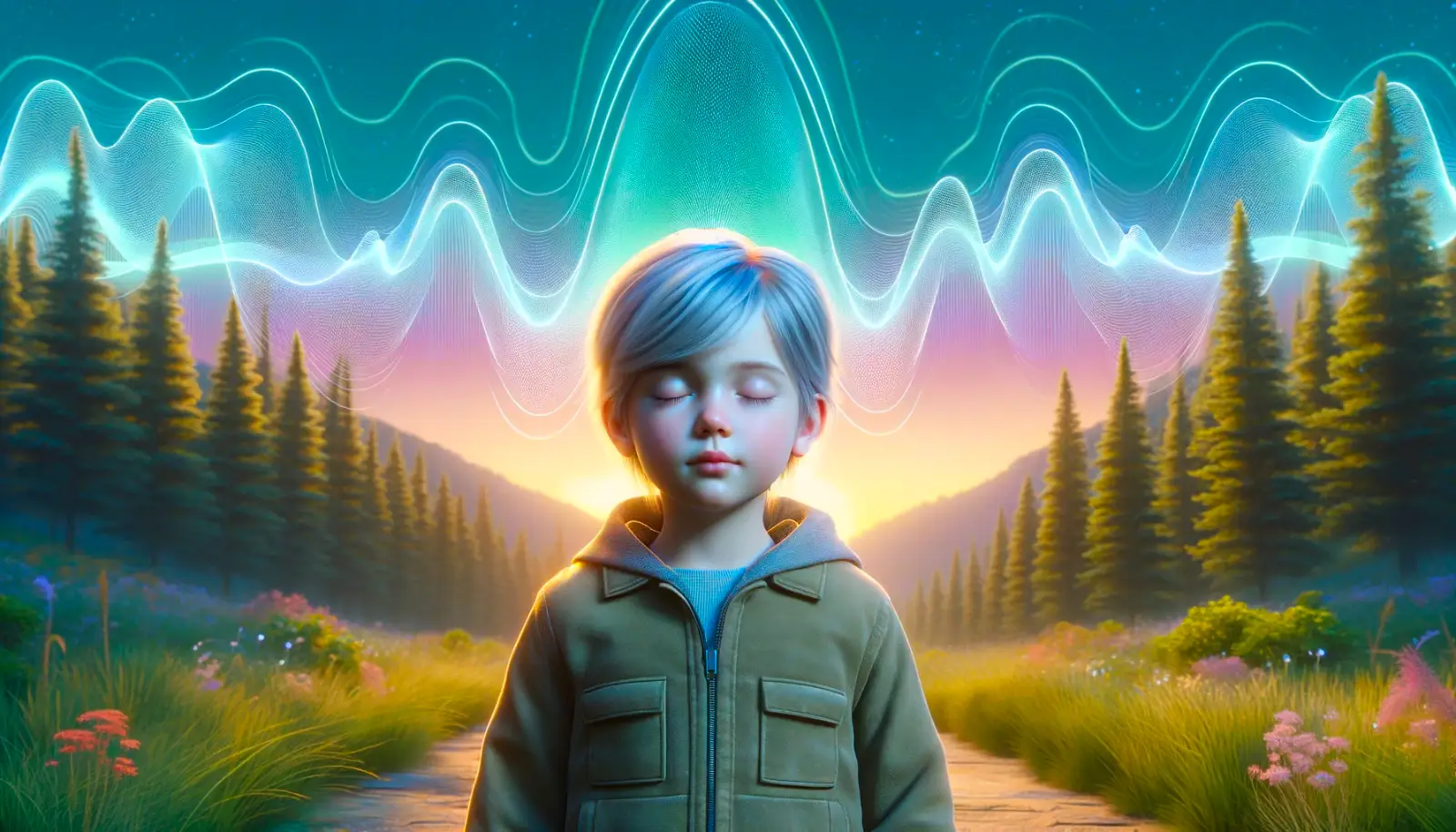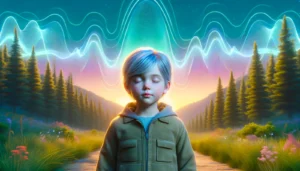ESCAPE INTO THE IMAGINATION
A JOURNEY THROUGH TIME AND SPACE
Have you ever observed your children lost in their thoughts, marveling at a discovery or struggling to focus on a task?
At times here, at times in their waking dreams, our children often wander between the physical world and that of the imagination.
These behaviors reflect the variations in the frequencies of their brain waves, electrical currents that shape their everyday lives.
Sometimes the brain needs to change state, or if you prefer, to take a break.
Paying attention to understanding the impact of these waves on your child’s attitude can be very beneficial for their development and daily learning.
You will then have the ability to interpret their needs, as well as to improve their receptiveness and cognitive performance, by introducing stimuli at the right time to capture their attention and avoid monotony.
BETWEEN CONSCIOUSNESS AND THE SUBCONSCIOUS
The state of brain waves in which a person finds themselves at any given moment leans more towards the world of the subconscious than that of the conscious.
Changing one’s brainwave frequency on demand relies on the learning and strengthening of a complex process of activating and deactivating neural networks.
This is why, for children, the most effective solution for changing states is based on conditioning.
Whether through hypnosis, meditation, or relaxation, it involves bringing the entire physical and mental state of the child into a process of letting go and visualization. Overexcitement can lead to a state of dissipation, while a lack of stimulation can lead to a loss of attention.
An adequate environment will greatly enhance your child’s learning abilities.

CHILD'S AGE AND THE EVOLUTION OF BRAIN WAVES
DELTA WAVES (0.5-4 HZ)
Starting with Delta Waves : A Brief Overview of the Evolution of Your Child’s Dominant Brainwave Frequency by Age.
Toddlers, especially newborns, spend a lot of time in the delta state, which is essential for their rapid physical growth and brain development. However, as they grow older, the time spent in this state decreases.
THETA WAVES (4-8 HZ)
During the kindergarten and elementary school years, children spend a lot of time in the theta state, which is associated with unbridled creativity.
This is also why children of this age have an astonishing ability to learn quickly – they absorb information like sponges.
ALPHA WAVES (8-14 HZ)
Around the age of ten, the brain begins to exhibit more alpha waves, indicative of calm and relaxation.
This is why meditation and relaxation techniques are particularly effective at this age.
BETA WAVES (14-30 HZ)
In adolescence, the brain is dominated by beta waves, which are typical of adults.
These waves are associated with logical and critical thinking.
GAMMA WAVES (OVER 30 HZ)
Less common, gamma waves are associated with perception.
They are often detected when the brain processes information from different areas and correspond to a state of heightened consciousness.
Chart of brain waves and the states they can be assimilated to.

DIFFERENT STATES OF CONSCIOUSNESS
DELTA WAVES : DOCTORS OF THE HUMAN VEHICLE

Delta waves are a particularly intriguing brainwave frequency, mainly associated with deep sleep. Their characteristics and effects on the human body are both fascinating and crucial for our well-being.
They are low-frequency brain waves (about 0.1 to 3 Hz) that predominantly occur during deep, dreamless sleep. This sleep phase is crucial for the body’s repair and regeneration, playing a vital role in physical and mental health.
These waves are considered the “reboot” of the human operating system. During sleep, delta waves facilitate the process of healing and tissue restoration, strengthening the immune system, and even consolidating memory. They are essential for quality rest and recovery, directly influencing our ability to function effectively in daily life.
If you haven’t already, remember to subscribe to the Eternal Forests Academy at the bottom of the page. You will receive support for introducing emotional intelligence to your children, as well as other techniques and tips, which will help you strengthen their inner development.
THETA WAVES : ACCESS TO THE SUBCONSCIOUS AND INTROSPECTION

Theta waves, oscillating at a lower frequency between 4 and 7 Hz, are particularly active during light sleep stages (including REM sleep) and in deep states of relaxation, meditation, and active imagination.
These waves provide access to the subconscious, where deep beliefs and habits are formed. In this state, the brain is receptive to visualization and suggestion, making it an ideal time for inner reflection and positive self-suggestion.
Theta waves play a significant role in learning and memory. Theta states can facilitate the reorganization of memories and experiences, which is crucial for emotional processing and psychological healing.
Ondes Alpha : Les Clés de la Détente et de la Créativité

Les ondes Alpha oscillent entre 8 et 15 Hz et sont souvent associées à des états de relaxation, de calme et de créativité. Elles deviennent dominantes lorsque nous fermons les yeux et nous détendons, mais restons conscients. Ces ondes facilitent la transition entre la conscience éveillée et les états de sommeil ou de méditation.
L’activité Alpha est cruciale pour la réduction du stress et l’anxiété, favorisant un état de détente mentale qui stimule la créativité et la pensée intuitive. Elles aident également à améliorer la concentration et peuvent augmenter la capacité de mémorisation et d’apprentissage.
BETA WAVES: THE STATE OF ACTIVE CONCENTRATION

Beta waves are a type of brainwave closely linked to the state of active wakefulness and concentration. They are particularly important for understanding how our brain handles cognitive tasks and alertness.
Beta waves are characterized by a relatively high frequency, typically ranging from 16 to 30 Hz. They are dominant when we are awake, alert, and engaged in mental activities that require conscious attention, such as logical reasoning, decision-making, or problem-solving.
In a beta wave state, the brain is engaged in active and focused mental activity. This state is essential for performance in tasks that demand sustained attention and for effectively managing stressful situations. Increased beta wave activity is often associated with improved concentration, alertness, and the ability to react quickly.
However, an excess of beta waves can also be linked to anxiety, restlessness, or hyperactivity, indicating a state of over-excitement in the brain. Therefore, maintaining a healthy balance between different types of brain waves is important for optimal brain functioning.
When a child is studying, they are typically in a beta state. Short but intensive learning sessions, followed by breaks, can optimize this state.
GAMMA WAVES: CATALYSTS OF HIGHER CONSCIOUSNESS

Gamma waves oscillate at a very high frequency, typically between 31 and 100 Hz, and are the fastest of the measurable brainwaves. They are often associated with states of heightened alertness, focus, and consciousness.
In the brain, gamma waves play a crucial role in processing information and synchronizing brain activities across different regions. They are essential for sensory perception, memory formation, and might be a key component of consciousness itself.
Gamma waves are also closely linked to meditation and expanded states of consciousness. Studies have shown that in experienced meditators, gamma wave activity significantly increases, suggesting a connection between these waves and mental states of heightened clarity and inner peace.
What is REM Sleep ?
REM (Rapid Eye Movement) sleep is a distinct phase of the sleep cycle characterized by rapid movements of the eyes. This phase is most commonly associated with vivid dreaming. The REM sleep stage exhibits several unique features:
Intense Brain Activity : During REM sleep, brain activity is similar to that seen when awake. Brain regions involved in learning, thinking, and organizing are particularly active.
Temporary Muscle Paralysis : In this phase, skeletal muscles are temporarily paralyzed. This paralysis prevents physically acting out dream activities, serving as a natural protective mechanism of the body.
Dreams : The most vivid and memorable dreams typically occur during REM sleep. These dreams are often narrative and can be highly elaborate.
Importance for Psychological Well-being : REM sleep plays a critical role in emotional processing and memory consolidation. Prolonged deprivation of REM sleep can impact mood and cognitive ability.
Sleep Cycle : REM sleep occurs several times throughout the night, approximately every 90 minutes. These phases get longer as the night progresses.
REM sleep is thus an essential part of the sleep cycle, important for mental health and overall well-being.
APPLICATION FRAMEWORK FOR CHILDREN
A BETTER UNDERSTANDING OF THEIR NEEDS
1. Sleep Routine : Ensure your child gets quality sleep. Sleep strengthens neural connections and consolidates memory. Relaxation before bedtime brings many benefits to the quality of sleep, and its long-term effects are impressive.
2. Short Study Sessions : Favor short study sessions over long hours, with breaks to facilitate assimilation.
3. Encourage Meditation : Even a few minutes a day can help strengthen attention and concentration.
4. Multi-Sensory Stimulation : Learning through play, hands-on experiences, or even travel can stimulate multiple brain regions at once, making learning deeper and more memorable.
For this, our Family Interactions coloring support will be a great help.

THE CHILDREN'S BRAIN : A MARVEL OF ADAPTABILITY
By understanding that their different states of presence are reflections of brain waves, you can gradually determine the ideal conditions to help your child learn, and also recognize when they are overwhelmed and in need of a break.
You will also understand that these breaks are not moments of emptiness but should be structured, ideally with relaxing music or a relaxation program designed for this purpose.
By adapting your approach, you can not only improve the quality of their learning but also strengthen their diligence in the long term.
Repeatedly practicing these techniques strengthens the neural circuits associated with the new habit, eventually leading to its automation in the subconscious. However, as with any skill or habit, the key lies in repeated practice and perseverance.






